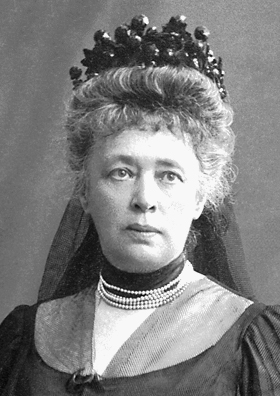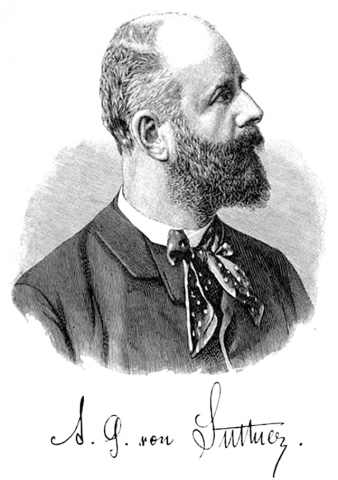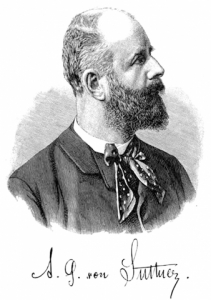Hidden Treasures? – Untranslated Tales of Yesteryear
Today’s Georgia is intent on telling her story to a wide range of international audiences – students from abroad, visitors, and the international business community. Georgia, produces attractive, accurate and engaging materials on the nation’s literary history, architecture, art, costume; publications include the contemporary take on detective fiction, futuristic and science fiction, women’s issues, and much else.
Yet one category of literature remains wrapped in comparative – if not complete – obscurity. What do we have on hand by way of 19th-century writer-traveler-explorer literature on Georgia? Works of the 1850s to 1900: more modern than archaic, more given to adventure and romance than to dutiful accounts of domestic life and small-farming? This was, after all the age in which the colorful works of Sir Walter Scott and Lord Byron were known to every educated Georgian. Action, adventure, escapism fueled rich and often exotic narratives.
The October 17th issue of Georgia Today carried an article on Alexandre Dumas’ engaging travelogue, Voyage au Caucase (1859), so rich in anecdote and excursions into the more dramatic episodes of Georgian history, but – sadly – still not yet translated in full in a modern, illustrated edition. But other authors writing on Georgia remain un-translated into English. Perhaps two of the most prolific were Artur Gundaccar von Suttner and his wife Bertha Kinsky von Wchinitz und Tettau – whose personal and professional live were full of romance and interest, and who merit rediscovery.
The story begins in Germany in 1864, in the spa town of Homburg vor der Höhe. Bertha, the then unmarried 21-year-old music-loving daughter of impoverished Czech aristocrats, was advised by her voice teacher that “The Princess of Mingrelia” had a “keen desire to make her acquaintance.” The princess was Ekaterina Chavchavadze Dadiani, the widow of Prince David, Dadian (hereditary ruler) of Mingrelia. With her options limited and under Russian pressure, Princess Ekaterina moved to St Petersburg, joining the Russian court, but with visits together with her children to Paris and to Homburg, where she was a widely recognized society figure. Bertha willingly met the princess, “a very elegant lady of forty-six or forty-seven, still goodly to look upon, and must in her youth been a dazzling beauty of the genuine Georgian type.“ A close friendship developed, and Bertha found her new life, with its “oriental, exotic quality, commingled with the Russian and Parisian tone of high society, spiced with romance and surrounded with the glitter of wealth” to be fascinating. So is Bertha’s biography, The Records of an Eventful Life (1910), in which she records a great deal more of the oriental, exotic and romantic . . . a fair amount of which involved her personally. Being told by Prince Erekle, the melancholy son of Giorgi XII, last king of Georgia, that she was “a magnificent girl” and meetings Emperor Alexander II of Russia and with Princess Anna Chavchavadze (who had been Shamyl’s captive in 1854), were only part of the fascination.

More than a decade later, in 1876, Bertha, now thirty-three, married Artur Gundaccar von Suttner; she had been a tutor to his sisters. Both sets of parents had hoped their child would marry into great wealth, and both were very disapproving of the match. The couple willingly accepted the invitation that Princess Ekaterina, now back in Mingrelia, extended to them to visit her. The wildly optimistic Bertha even hoped that the Princess’ son Niko, now the nominal Dadian of Mingrelia, would secure Artur “a position as aide to the emperor [Alexander II] or something of the sort.” Nothing of the sort eventualized, but after a typically warm Georgian welcome, which Bertha eloquently describes in her biography, together with details of the journey, receptions and a long stay in the summer palace at Gordi, the von Suttners made every effort to pay their way. The couple moved to Kutaisi, where they taught music and German to the children of wealthy families; in addition, they wrote Georgian-themed articles for German-language newspapers in Europe.
In 1877, the couple moved to Zugdidi, where Ekaterina’s daughter Salomé had set up home with her husband, Achille Murat, grandson of Napoleon’s General Murat Artur von Suttner took up estate management, assisting both Achille and also Ekaterina’s son Niko with their properties, including installing “horse-thief-proof stalls.” Then, after Princess Ekaterina’s death in 1882, the couple moved to Tbilisi, where Artur’s attempt to start a timber business proved unsuccessful.
All in all, Bertha and Artur made the best of a challenging but enjoyable decade in Georgia, throwing themselves into every sort of practical work but also remaining avid autodidacts, immersing themselves in the books of Darwin, Haeckel, Spencer, Whewell Buckle and other scientific worthies of the period, both European and Georgian. Then in 1885, Artur’s reconciliation with his parents permitted the couple to repatriate themselves back to his family’s castle in Harmannsdorf in Lower Austria.
Though almost entirely unknown today, the couple’s journalistic writings on Georgia certainly deserve re-examination; both were much published writers of tested skills. But also of great interest is Artur’s literary work. In a chapter of her biography that covered 1877, Bertha states “My husband’s Caucasian stories and novels were meeting with great success, and my Inventarium einer Seele . . . and belles-lettres were equally in demand.” Artur published at least eight “lost” novels or narratives on Caucasian and Georgian themes, among them: Daredjan: Mingrelisches Sittenbild (1886); Ein Aznaour: kaukasischer roman (1886); Der Battono (1886); Kinder der Kaukasus (1890); Die Adjaren (1890); Schamyl (1891); Ein Dämon (1895); and Die Tscherkessen: roman (2 vols); 1896-98). (The English-language titles would be: Daredjan: A Portrayal of Mingrelian Customs (1886); An Aznaour: A Caucasian Novel (1886); The Prince (1888); The Children of the Caucasus (1890); The Ajarans (1890); Shamyl (1891); A Demon (1895); and The Circasssians: a novel (1896-98). (As the publication dates of all these works fall after the von Suttners’ return to Austria, it is likely that at least the earlier books were first serialized in Austrian and German magazines or newspapers during the couple’s sojourn in Georgia, and that book-form publication came later.)
Intriguingly, in 1890 a novel by Artur von Suttner titled Djambek the Georgian was published in English in New York – it is likely to be a translation of Die Ajaren, 1890. In it von Suttner presents the adventures of Djambek, a resident of Ajara (a Georgian province held by the Turks until 1878). The anonymous reviewer of The Critic, Vol. 16. May 1890, states:
DJAMBEK THE GEORGIAN is called a ‘Tale of Modern Turkey,’ but it is Asiatic Turkey that the author means, for the hero only leaves his native province for the neighboring Russian (sic) territory to return to it with a Russian army. Djambek, a young Georgian landed proprietor, falls in love with the grand-niece of his Pasha – a bewitching damsel, who had been educated at the French school in Trebizond, and has quite modern and Western notions of women’s rights. His love is returned, but he loses the Pasha’s favor by insisting on reforms the latter is too indolent to carry out. He plans on elopement but is caught and clapped in a prison. The extortions of the subordinate Turkish officials drive his countrymen to revolt. They release Djambek, who aids in maintaining a guerilla warfare on the borders, until the outbreak of the Russo-Turkish war brings him a commission and an opportunity to regain the charming Tamar, and to pay off old scores.
Having had the pleasure of reading the book (ordered on-line), I certainly agree with the reviewer’s final comment – “There is plenty of stirring adventure and picturesque description [in it],” and would add that the story moves rapidly and that it also presents incisive analyses of power structures, local conditions and Turkish and Georgian daily life.
What then of Artur’s other Caucasian works? None appear to have been translated into English; all exist in only a handful of copies housed in no-loans- permitted European national or university libraries. Ein Aznaour is the rarest title; only one copy is listed.
Can we hope that Georgian literary scholars will meet with their German and Austrian counterparts who specialize on Georgia and together examine Artur’s novels and Bertha’s journalism? Can we hope for any translations into English of Artur’s colorful and vivid works on Georgia or Bertha’s commentaries on daily life? The titles of the novels indicate a great variety of time periods, regions, and protagonists, and we could certainly expect accurate and perceptive work; Artur and Bertha kept in continuing touch with a wide range of European and Georgian scholars, and their work received much praise. Both were avid students of Georgian history and literature – even completing an unpublished German language-version of The Knight in the Panther Skin.
Artur and Bertha’s works – books and journalism – are a buried treasure, a huge and long-unopened album capturing a vast range of Georgian scenes. The urgent challenge of rediscovery must be seen as a great opportunity to present colorful Georgian history and life to new generations of readers. (1497)
By Peter Skinner











